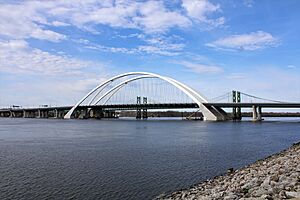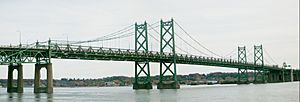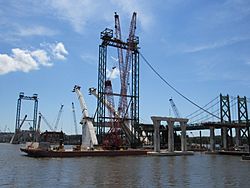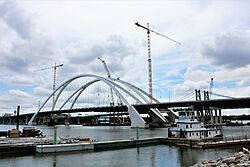I-74 Bridge facts for kids
Quick facts for kids Interstate 74 Bridge |
|
|---|---|

New and old bridges in 2022.
|
|
| Coordinates | 41°31′01″N 90°30′38″W / 41.51694°N 90.51056°W |
| Carries | 8 lanes of |
| Crosses | Mississippi River |
| Locale | Bettendorf, Iowa, and Moline, Illinois |
| Official name | Iowa-Illinois Memorial Bridge |
| Maintained by | Iowa Department of Transportation |
| Characteristics | |
| Design | Twin basket-handle, through arch |
| Longest span | 800 ft (244 m) |
| History | |
| Opened | November 13, 2020 (northbound) December 2, 2021 (southbound) |
| Statistics | |
| Daily traffic | 80,000 |
The Interstate 74 Bridge, officially known as the Iowa-Illinois Memorial Bridge, and often called The Twin Bridges, or the I-74 Bridge, are basket-handle, through arch twin bridges that carry Interstate 74 across the Mississippi River and connect Bettendorf, Iowa, and Moline, Illinois. It is located near the geographic center of the Quad Cities. They replace two suspension bridges opened to traffic in 1935 and 1959, both of which had become obsolete by the 1990s.
Contents
History
| I-74 Bridge (original) | |
|---|---|

The old bridges as seen from the Iowa side of the Mississippi River,before any construction began.
|
|
| Coordinates | 41°31′12″N 90°30′48″W / 41.52000°N 90.51333°W |
| Carries | 4 lanes of |
| Crosses | Mississippi River |
| Locale | Bettendorf, Iowa and Moline, Illinois |
| Official name | Iowa-Illinois Memorial Bridge |
| Maintained by | Iowa Department of Transportation |
| Characteristics | |
| Design | twin arch bridges |
| Total length | 3,372 feet (1,028 m) |
| Width | 27 feet (8 m) |
| Longest span | 227 metres (745 ft) |
| Clearance below | Mississippi River |
| History | |
| Opened | November 18, 1935 (first span) December 22, 1959 (second span) |
| Closed | November 13, 2020 |
| Statistics | |
| Daily traffic | 80,000 |
| Toll | Former, abolished December 31, 1969 |
Before the first span was built, the only bridge in the Tri Cities was the Government Bridge between Rock Island, Illinois, and Davenport, Iowa. William P. Bettendorf, founder of the Bettendorf Company and namesake for the city of Bettendorf, began planning a toll bridge between Bettendorf and Moline in 1907. The year before, the United States Congress passed a law allowing private citizens to build a bridge as a business venture. Bettendorf died in 1910 and the momentum to build the bridge died with him.
Original Span
Before the first span was built, the only bridge in the Tri Cities was the Government Bridge between Rock Island, Illinois, and Davenport, Iowa. William P. Bettendorf, founder of the Bettendorf Company and namesake for the city of Bettendorf, began planning a toll bridge between Bettendorf and Moline in 1907. The year before, the United States Congress passed a law allowing private citizens to build a bridge as a business venture Bettendorf died on June 3, 1910. In 1931, the city of Davenport along with a group of local businessmen formed the Davenport Bridge Commission to construct the new bridge. Moline refused to grant the franchise for the bridge and the early years of the Great Depression made it difficult for the businessmen to finance it on their own without the city's help. IN 1927, the idea of this bridge was revived after After several setbacks because of design and location issues, bonds were issued for the building of this new bridge in February 1934. Construction of the bridge began on July 1st of that year. It was designed by engineer Ralph Modjeski. With finishing touches being completed on November 16. The bridge opened on November 18, and tolling began the next day. Tolls were set at 15 cents for passenger vehicles and light trucks, 30 cents for heavy trucks, and 5 cents for pedestrians.
Twinning
At the end of World War II, traffic increased substantially on the bridge, prompting studies for a possible widening of the crossing to four lanes. This issue prompted the need to either widen the existing bridge or construct a second one. Because of this Mojeski and masters were called in 1951 to study the feasibility of constructing a second twin span. At the cmopletion of these studies, it was determined a second twin span would be the best opition. On July 16 1952, a bill to construct this span was passed under the 82nd congress, the next day president Harry S. Truman signed the bill into law.. While construction was supposed to start in 1956, bidding for a contractor did not start until May 6, 1958. Groundbreaking for the bridge began on July 1, 1958. It was to be constructed as close as possible to the existing span, this was done to avoid demolishing more historic buildings than necessary. By February 1959, the suspender ropes had been completed, and construction of the superstructure commenced. The bridge was completed in November 1959, and put into service on December 22 that year. Money from tolls paid for most of the new span. At this point, all traffic was routed onto the new bridge, and the original one was temporarily closed for a extensive reconstruction. New loop ramps were constructed on the Bettendorf approach to allow for increased traffic to more adequately cross the bridge. In Moline, land was cleared for a new approach that carried traffic to 19th Street and 3rd Street, the old approach had only carried traffic to 20th Street and 3rd Street. Because of this, the patterns of that part of the city were altered to increase the flow of the ever increasing traffic. The upstream span, the older of the two, reopened to westbound traffic on July, 1, 1960. On January 20, 1961, the new span was dedicated, its plaque laid on the same pedestal as the original 1935 spans, which had been relocated to sit near the new span. Unlike the first span, the second Iowa and Illinois soldiers to those who died in all wars, as opposed to only the Great war.
Upgrade to interstate standards
In 1965, plans to purchase the bridge were made by the US government, who wanted to route I-74 over them. The Davenport Bridge commission had hoped that the Government would have let them continue charging tolls on the bridge, however, they did not, and a deal was struck that when enough toll money was collected, the bridge would be rehabilitated and reconstructed to interstate standards. When this goal was met, the US government bought the bridges on December 31, 1969, and work began on the project in November 1971, with the removal of the toll plazas. After this word began on replacing the guardrails and removing the sidewalks from the westbound span, removing the toll plaza and toll offices, and demolishing the approaches and replacing them with new elevated ramps. The road capacity was temporarily restored to two lanes as reconstruction work required the closure of one span at a time. Completion of the project was delayed due to funding issues caused by the Vietnam War. The Bridges were reopened on November 26, 1974, and I-74 was finally routed over the bridges by December 10th, 1975, at which point Iowa DOT and Illinois DOT took control of the bridge. Also around this time, the plaque was relocated again to sit next to the 1935 span once more. Im=n addition, its pedestal was memorialized to veterans of the Korean and Vietnam wars as well.
Issues and replacement
Built for a daily crossing of 48,000 vehicles, in its later years the daily average grew to 80,000, making it by far the most traveled bridge in the Quad Cities. In 1994, the Illinois Department of Transportation had requested a study of bridges from the Fred Schwengel Memorial Bridge to Sergeant John F. Baker Jr. Bridge in the Quad Cities and the Bi-State Regional Commission agreed. The other two Interstate bridges were up to Interstate standards, while the Interstate 74 Bridge was functionally obsolete and not built to Interstate standards, as both of them predated I-74's routing through the area. Each span had two narrow lanes, no shoulder, and a 50-mile-per-hour (80 km/h) speed limit. Additionally, by the 2010s, both bridge's had become structurally deficient, requiring constant maintenance to keep in service. While on a tour at the base of the bridge in Bettendorf in May 2012, U.S. Transportation Secretary Ray LaHood said that, in comparison with other bridges that he has seen in other states, the I-74 Bridge is one of the worst he's seen. Because of this, The I-74 Corridor Study was completed to study replacing the old spans with larger ones that had 4 lanes each. The study claimed that the I-74 Bridge project would spur economic growth, create construction jobs, reduce traffic backups, and improve air quality. Funding for the construction of the new bridge had been earmarked for $22 million in 2017 and $50 million in 2018. Former Illinois Governor Pat Quinn said the state is committed to bridge improvements to help traffic flow and "boost economic growth in the region". By 2012, the Illinois Department of Transportation budgeted more than $34 million for engineering, design, and land acquisition for the new bridge. The conceptual design of the arch bridge was completed by CH2M Hill and Boston-based bridge designer Miguel Rosales from Rosales + Partners. Final design was completed by Modjeski and Masters in association with Alfred Benesch & Company. The portion of the bridge spanning the Mississippi River was estimated at more than $700 million, while the project as a whole, including all approach routes and connectors, was estimated at $1.2 billion. A ground-breaking ceremony for the new bridge was held on June 26, 2017. By 2019 construct on the new westbound span was long underway, however it required demolition of the existing eastbound viaduct in molline. The new bridge was expected to be completed in 2020.
On November 13, 2020, the Iowa-bound side of the new bridge opened to motorists, the old bridges were then permanently closed, and construction on the new eastbound bridge commenced. The bridge was officially dedicated on December 1, 2021. Speakers included Congresswoman Cheri Bustos, Illinois Governor J. B. Pritzker and other state and local officials from both Illinois and Iowa. The second span for Illinois-bound traffic was opened the following evening. The pedestrian and bike path was opened on April 27, 2022. An elevator up to the walkway in Bettendorf has yet to be completed.
Demolition of the old spans
On June 9th 2022, demolition of the last approach viaducts was deemed mostly complete. The contract for deconstructing the suspension bridges was awarded in September 2022 to the Helm Group, the company who had a part in constructing the new viaducts in downtown Bettendorf. Because it would be taken down piece-by-piece, demolition of the old bridge was not expected to be completed until early 2024. On May 17, 2023, it was announced that the towers and cables on the Illinois-bound side of the old bridge would be demolished using explosive charges. The demolition would take place on a Sunday morning between June or July, though the exact date was not revealed. On June 18, 2023, the trusses of the deckless Illinois bound span were detonated with explosives, leaving only a small part of the bottom superstructure to be removed in a future demolition. By July 2023, the Iowa bound bridges superstructure had been fully removed, its steel was then sold as scrap metal. On August 27, 2023, the Iowa bound trusses were also blasted, in addition to the implosion of the Illinois bound piers. The third detonation occurred on October 15th, with the Iowa bound piers being imploded. The fourth and final implosion occurred in the early hours of February 18, 2024, with the Illinois sides anchorage being impolded. One of each of the original piers was left in place at the back segment of the channel. Lights have been installed to reduce the likelihood of collision.



